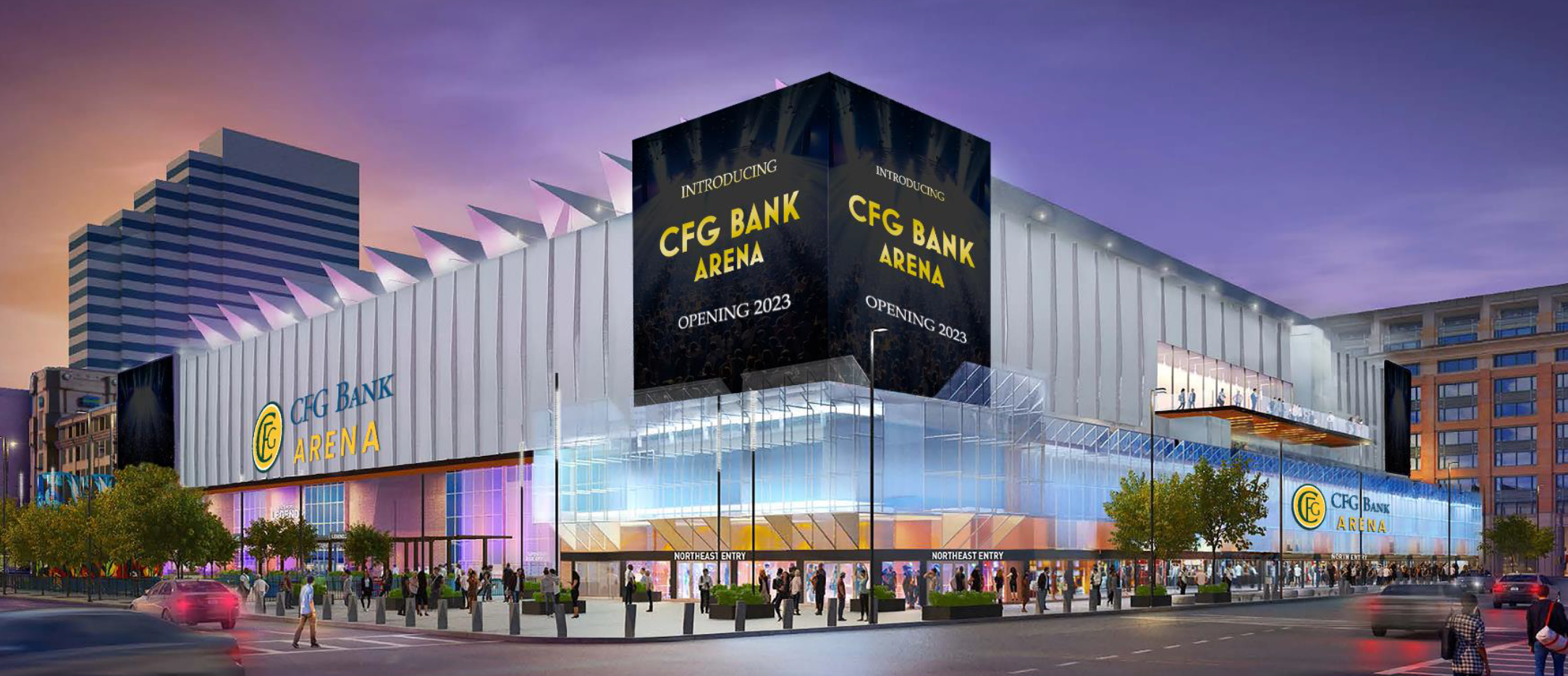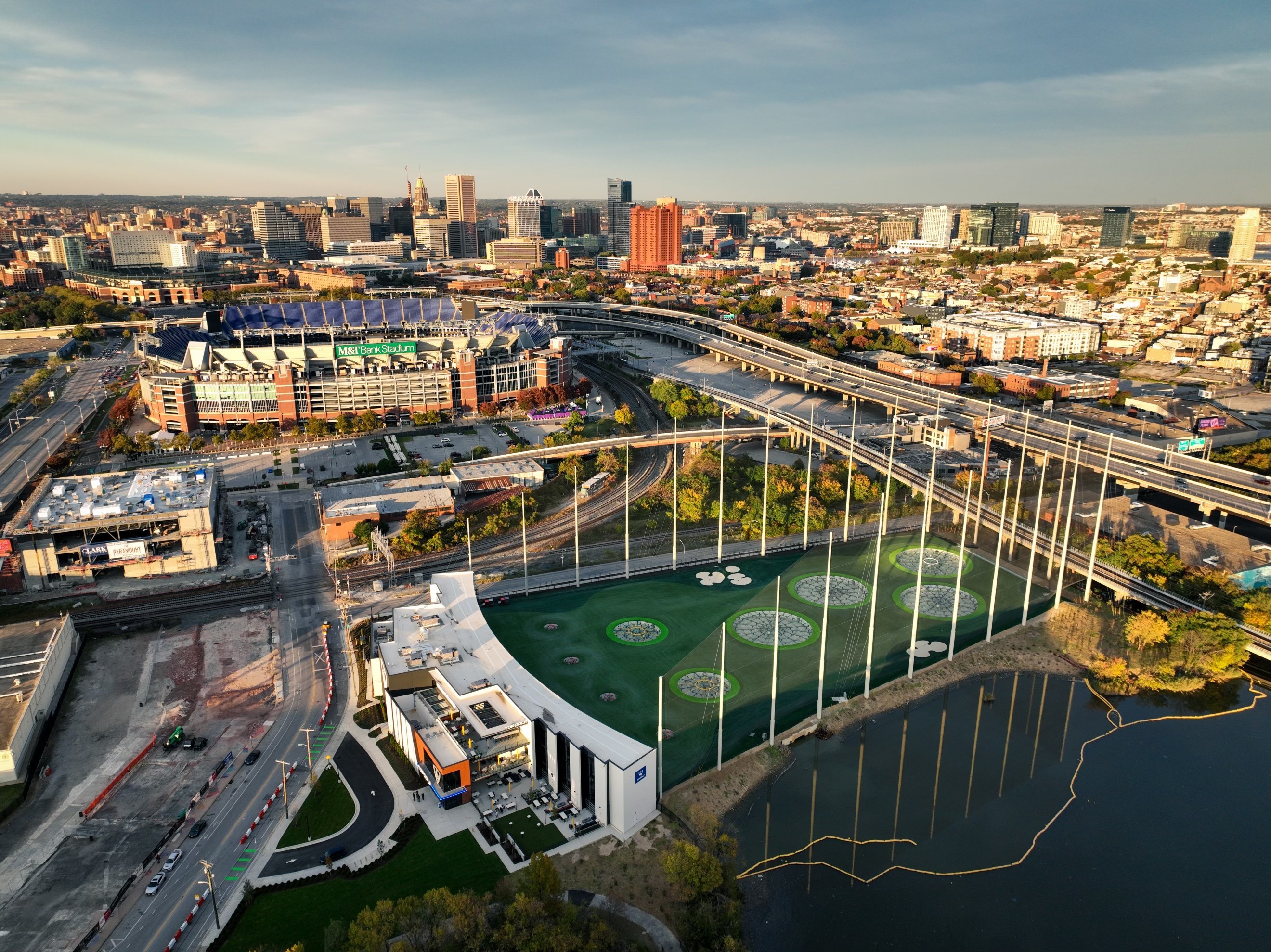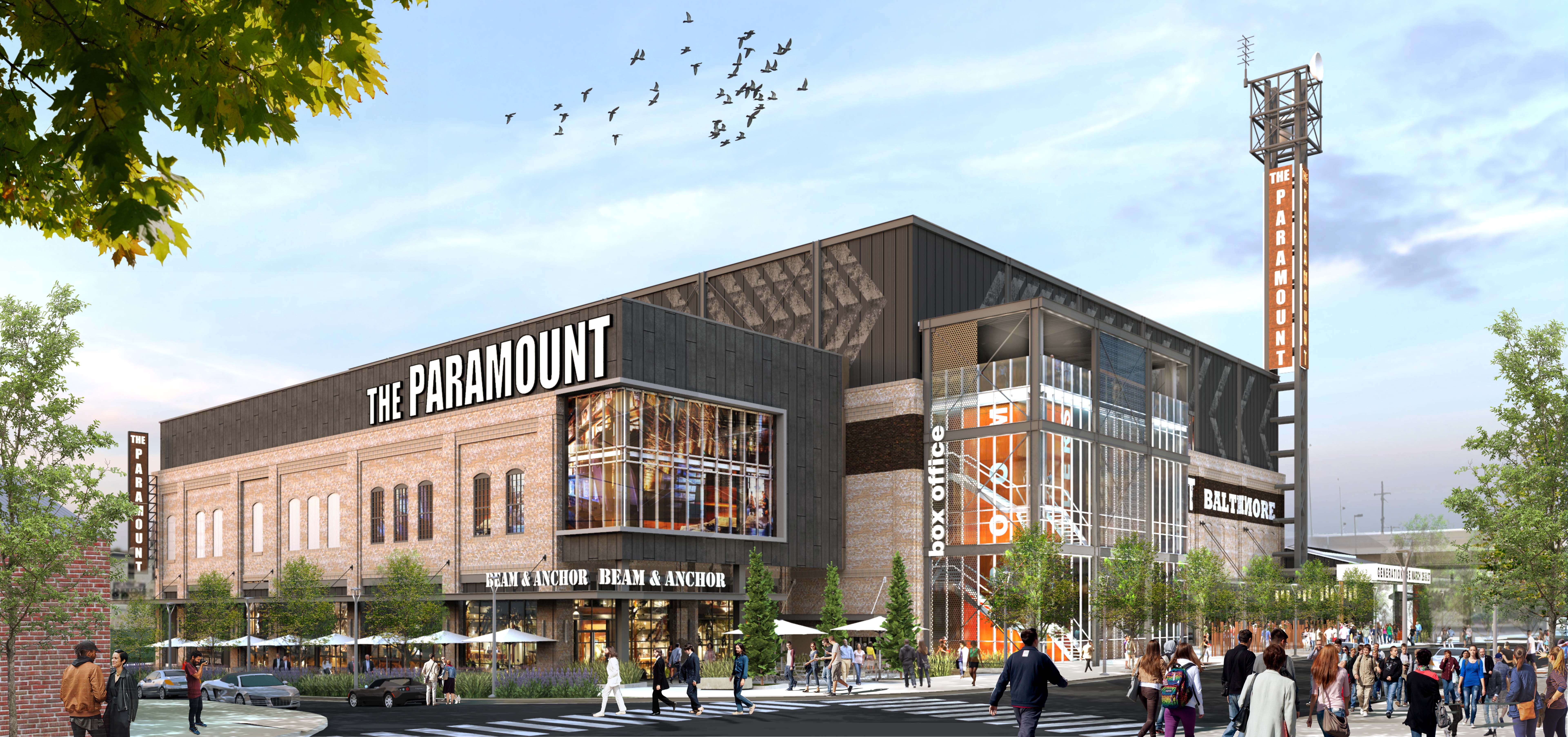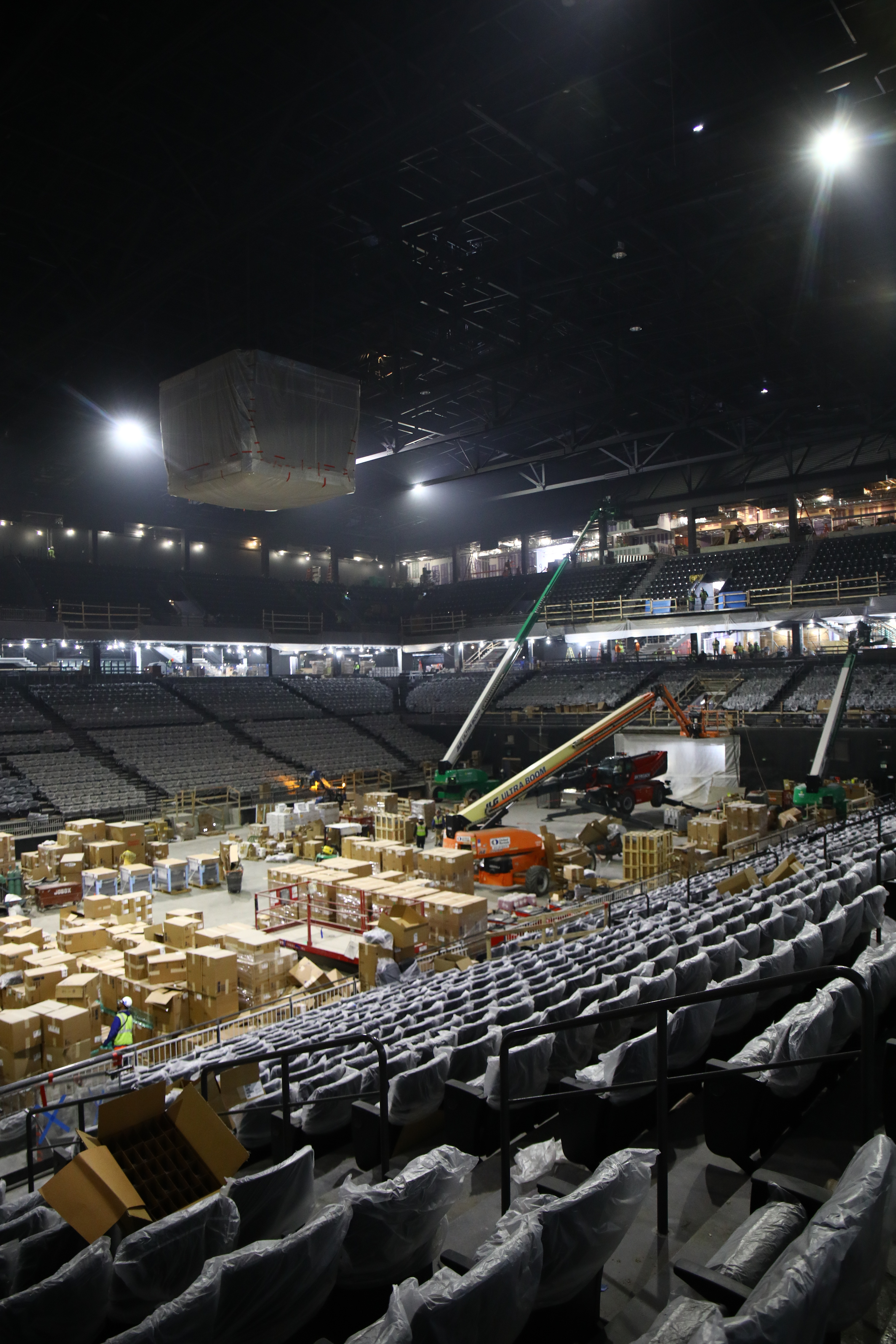
Redevelopment has kicked off at the CFG Bank Arena in Baltimore. Image courtesy of The Oak View Group.
In case the prospect of seeing Bruce Springsteen, Janet Jackson, Lizzo or other superstars perform in Baltimore doesn’t excite you, consider a few numbers instead.
Current investment in entertainment and sports facilities in Baltimore is nearing $400 million – more than $200 million for the CFG Bank Arena, another $100 million-plus for The Walk @ Warner Street and $50 million for The Paramount Baltimore.
The number of people those projects is expected to bring into the city annually amounts to 450,000 visitors to the Paramount, 500,000 to the recently opened Topgolf and possibly 1 million people to CFG Bank Arena.
The anticipation of roughly 2 million downtown visitors yearly is stoking prospects of other developments, including a mixed-use hotel and retail facility at 1400 Warner Street and the planned 30,000-square-foot Yards Social Bar.
Those kinds of numbers raise fundamental questions for the city: Could those investment levels and development projects position Baltimore to establish a vibrant, stable entertainment hub that stretches from Lexington Market past the Hippodrome, CFG Bank Arena, Camden Yards, M&T Bank Stadium to Topgolf and the Horseshoe Casino? And could those initiatives, as some supporters predict, prove transformational to Baltimore’s economy and reenergize downtown?
“My brutally honest answer is I wouldn’t have worked on this for the past 15 years if I didn’t think the impact would be big,” said Kim Clark, Executive Vice President of the Baltimore Development Corporation (BDC).
The Oak View Group, the global sports and entertainment company that is redeveloping the arena, intends to book 130 to 135 events annually, including about 40 A-list concerts — up from the old arena’s track record of hosting 105 events, just three A-list concerts and 500,000 visitors annually at peak.
The gut renovation of the 60-year-old building will nicely equip CFG Bank Arena to meet those numbers, said Frank Remesch, the arena’s long-time General Manager.
Baltimore has long been regarded as a prime entertainment market, he said. It draws from a surrounding population of nearly 8 million people and ranks as the 27th largest market in the country. Touring acts typically aim to book in top-30 markets.
“The city was never the question. However, the building didn’t help you book shows or sell tickets,” Remesch said. “The acoustical tile ceiling made it miserable to rig shows, miserable. We lost shows because riggers had to understand advanced trigonometry to work with that ceiling. We had to give some acts a full, pre-rig day which cost us a day of operations and revenues.”
The building’s HVAC system dated from the 1960s, the roof and exterior cladding leaked, limited power supply forced some acts to bring in generators, loading equipment into the arena was difficult, some seats had poor sightlines and the facility lacked amenities, such as suites and attractive, efficient merchandise and food concessions.
When the renovation plan was completed, Remesch began pitching it to production companies. “Their immediate response was, ‘We’re in.’ It was that quick and easy because they love this town.”
“The arena redevelopment opens our doors to opportunities that were passing us by for years,” said Terry Hasseltine, Executive Director of the Maryland Sports Commission and President of Sport and Entertainment Corporation of Maryland. “With a dated arena, we would lose concerts, family shows, sporting events to smaller markets in the DMV and the MidAtlantic that had better facilities… Building a first-class arena in Baltimore is a huge, huge step. You are going to see everything coming to the arena from world-class concerts to collegiate sporting events, pre-season games for the NBA and the NHL, and family shows. It is a gateway to new opportunities.”
Designed to meet the needs of concerts, the renovated arena includes improved acoustics, dressing rooms, loading and rigging facilities, premium suites, an “intimate bowl” that places crowds and performers close together and “I promise you there is not a bad seat in the house,” said Paul Young, Senior Vice President Project Management for the Oak View Group.
Those qualities, he added, will not only attract concerts but make Baltimore a prime destination for concert-goers. “I think the time will come when people realize if a performer you love is touring, it will be worth following them to Baltimore because you will have a better concert experience here.”
Increased activity at the arena could also spur other economic growth nearby.
“You will absolutely see a resurgence of the west side. There’s no doubt in my mind,” Remesch said. “There are not enough restaurants here currently. The Howard Street corridor is going to take off because there will be new reasons to be here.”
“There will be a tremendous number of opportunities stemming from the arena itself,” Clark said. “It will help restaurants and bars that have been suffering and bring a lot of life back into this area. It will also kickstart other developments that have been stagnant for a number of years, creating even more opportunities.”
Bringing more life back to the downtown core, however, also depends in part on Baltimore easing some longstanding problems, such as the city’s crime rate. Baltimore recorded 332 homicides in 2022 and has consistently experienced between 300 and 348 homicides annually over the past eight years. Another 700 people were injured in shootings in 2022. National crime analysis completed by Security.Org concluded that Baltimore ranked as the sixth most dangerous city in America. It ranked number 11 for murders and other violent crimes per capita, but number one for robberies.
Advocates for development projects say increased activity downtown will help deter crime while associated job creation (the Topgolf development alone is slated to create 600 jobs) will provide new opportunities to area residents.
Other entertainment and sports developments downtown could spur additional growth.
The owners of the Horseshoe Casino have started developing The Walk @ Warner Street. Inspired by entertainment districts in Las Vegas, New Orleans, Dallas, St. Louis and elsewhere, the initiative will upgrade infrastructure (widened sidewalks, underground utilities, etc.) between the casino and M&T Bank Stadium, setting the stage for a mix of new venues.
“We hope The Walk provides entertainment opportunities that cannot be found elsewhere in the region,” said Arthur Adler, Partner at Caves Valley Partners.

Baltimore’s new Topgolf facility is expected to support 600 jobs, attract 500,000 visitors annually and entice other hospitality venues to locate nearby. Image courtesy of Topgolf.
Topgolf has already opened and construction has started on The Paramount – a $50 million, 3,750-seat concert venue. Such venues, Adler said, “should bring more people to the stadium area at times other than sporting events. We expect the economic benefits to the city from The Walk to be significant.”
“We have already seen really great interest in Warner Street,” Clark said. “I credit a lot of that to the local development team for the casino because of their national and international connections. Once something like Topgolf opens in a location, there are other entities that follow.”
In other markets, restaurants, bars, movie theaters and other family-friendly and adult-focused entertainment venues have opened up adjacent to Topgolf, Hasseltine said.
Construction of the Paramount could further increase Baltimore’s ability to attract concerts, he added. “A venue of that size has been a missing element in Baltimore. It is what our market needs. The intimacy of that kind of space is so appealing. And with the casino, M&T Bank Stadium and Topgolf right there, the whole area is going to have a great buzz.”
Furthermore, the Paramount, CFG Bank Arena and Pier Six, located on the other side of the Inner Harbor, collectively could attract more and varied entertainment events to Baltimore, Hasseltine said.
“Sometimes you will hear from organizers that they want to place Act A in an arena, but Act A is eager to support an up-and-coming group and wants them to perform in the same market maybe a day or two later. The Paramount or Pier Six could be perfect for that. Those venues could support each other and help everyone thrive,” Hasseltine said.

